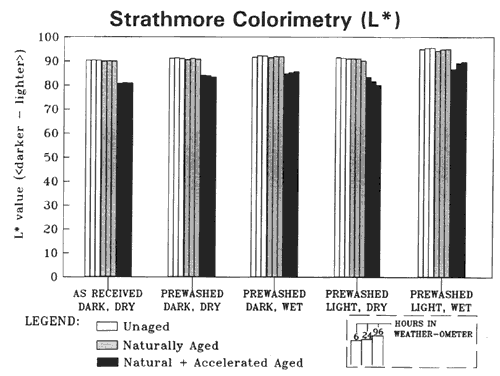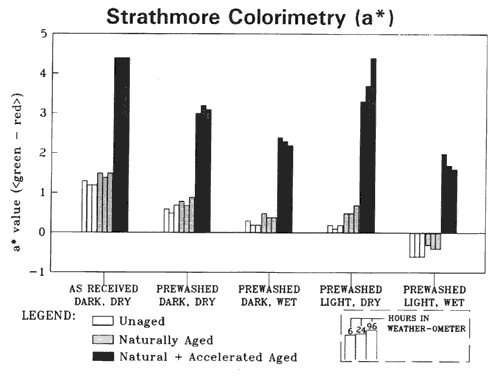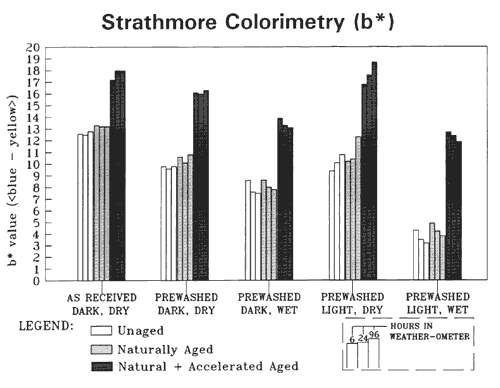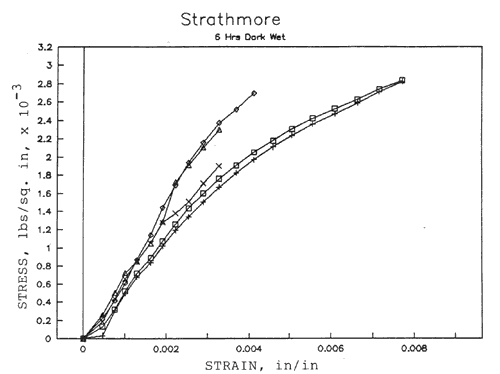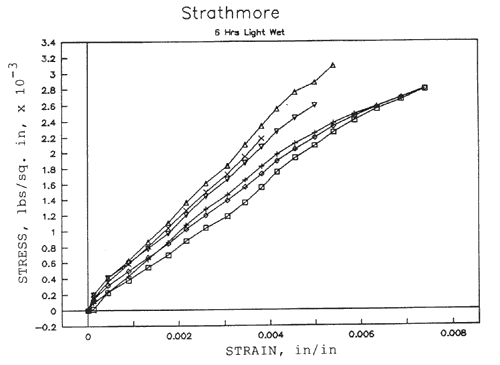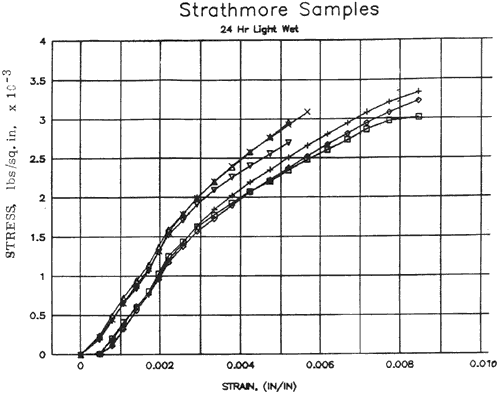Effect of Aging on an Aqueously Light Bleached, Mixed Pulp Paper
by Terry Trosper Schaeffer, Mary T. Baker, and Dianne van der ReydenWork performed at Conservation Analytical Laboratory, Museum Support Center, Smithsonian Institution, Washington, D.C. 20560.
Abstract
Aqueously light bleached samples of a mixed pulp, alum rosin sized paper, and samples which had been exposed to various control conditions, had undergone natural aging for two years while stored in the dark in unsealed polyester photo sleeves. At the end of this storage period, all paper samples were found to have darkened considerably. These discolored paper samples were further darkened markedly, and also significantly embrittled, by artificial aging. The changes in mechanical properties upon aging did not appear to be influenced specifically by the aqueous light bleaching treatment.
Introduction
In 1988 van der Reyden, et al., reported the results of an investigation of the effects of aqueous light bleaching on some properties of a naturally aged, alum rosin sized, mixed pulp paper and two different unsized papers 1. Several properties of the aqueously light bleached samples were compared to those of identical paper samples which were kept in the dark, either immersed or dry, or exposed to light while dry for the same time periods. Aqueous light bleaching significantly lightened the sized paper, as compared to the effects of exposure to the other conditions, and did not appear to have a significantly deleterious effect on the strength of the samples as measured by relaxation tensometry. The long term effects of the aqueous light bleaching treatment were not studied in this earlier work.
The consequences of aqueous light bleaching for the appearance and durability of the paper over the long term are also of concern to conservators. This question can be addressed experimentally by storing the treated samples for long periods of time 2, or by artificially aging the samples following treatment (3-5, and subsequently characterizing them as had been done originally. The samples from the 1988 experiments had been retained, so a limited study of the effects of both of these aging processes on the mixed pulp paper samples could be undertaken.
The paper samples were again characterized physically by quantitation of their color and by measurement of their tensile behavior when subjected to relaxation tensometry 6. As had been concluded from the results immediately following exposure of the samples to aqueous light bleaching or to various control conditions, the former treatment does not induce a significant degradation of the paper properties upon aging, beyond that which was observed in the samples that underwent "control" treatments. The results of this brief follow-up investigation are summarized below.
Materials and Methods
1. Materials.
A Strathmore mixed pulp, alum rosin sized paper was used in the earlier experiment. Evenly discolored sheets of this naturally aged paper had been taken from within a stack. The detailed composition of this paper has already been reported 1. The major component is chemically treated softwood, with some hardwood and cotton present also.
Many of the Strathmore paper samples retained from the previous project were suitable for use in this investigation. All of these samples had been stored in archival quality polyethylene photo sleeves in a binder at laboratory temperature and relative humidity since their earlier treatments. No attempt had been made rigorously to exclude light from the stored samples; however the storage location of the binder resulted in minimal exposure of the samples to light.
2. Experimental Plan.
Spot tests for aluminum were performed on selected samples to determine whether alum sizing had been lost during the previous Weather-ometer incubations. Surface morphology and elemental analyses were investigated by SEM/EDX.
In order to determine the effects of "natural" aging during the approximately two year storage period, the appearance of the samples was quantitated by colorimetry using CIE L*a*b* values. Selected samples were artificially aged under humid conditions, and the colorimetry measurements repeated. Finally, the mechanical condition of some of the artificially aged samples was measured by relaxation tensometry.
The effects of aging were assessed by comparison of the data from the above measurements with the properties of the paper samples which were reported earlier 1, i.e., properties used to monitor the condition of the papers immediately following the treatments they received in the earlier experiment.
3. Experimental Methods.
Aqueous light bleaching and control "treatments":
These procedures were performed in the earlier experiment, and have been described in detail in the previous publication 1. To summarize: a piece of each paper was reserved as untreated. The rest of the samples were prewashed in dilute Ca(OH)2 and dried under light weight (< 0.1 psi). These samples, and some of the untreated paper, were individually exposed to various conditions of light or dark, immersed in dilute Ca(OH)2 or dry, in an Atlas Weather-ometer for periods of time ranging from 2 to 96 hours.
Artificial aging:
Selected samples of the Strathmore paper used in the earlier experiments were sewn with cotton thread into plexiglas frames for humid oven aging. The samples were positioned with the machine direction vertical and anchored at both top and bottom so that no samples were touching. Samples were artificially aged for 20 days in the dark at 90°C and 50% relative humidity in an Associated Environmental Systems HK-4116 Temperature/Humidity chamber. These conditions have been chosen previously as suitable for artificial aging studies 7,8. Washed samples which had not been subjected to incubation in the Weather-ometer in the previous experiment were aged at the same time. At the end of the aging period, the plexiglas frames were removed from the oven. The samples were equilibrated for at least 24 hours at room temperature before being cut out of the frames and stored in polyester film enclosures.
Analytical procedures:
Spot tests for aluminum were performed according to Browning 9 on small pieces of selected samples of the papers. Papers known to contain alum, and Whitman 1 filter paper, were used as positive and negative controls, respectively. The Raspail spot test for rosin size was found to give inconclusive results with a fresh and an artificially aged Strathmore sample. Thus it was rejected as a useful means of identifying rosin in samples.
Thin strips of samples to be examined by SEM/EDX were coated with carbon after being mounted on stubs for electron microscopy. The JEOL JXA-840A scanning electron microscope with a Tracor Northern TN5502 energy dispersive X-ray analysis accessory was used to obtain representative micrographs of the paper surface and for elemental analysis, respectively. Dot map representations of element distributions were recorded where appropriate. "Tide lines" that appeared at the top edges of some Strathmore samples after artificial aging were also examined using this technique.
Paper color was quantitated with a HunterLab Ultrascan Spectrocolorimeter, using CIE L*a*b* notation. The instrument was set for a 10 degree observer, the small area of view (1/4 inch diameter) was used, and specular reflectance was included. Spectra were recorded from 375 to 750 nm, using the visible light source, at three different locations on each side of each paper sample. The triplicate readings were averaged.
Tensile properties were measured using the Conservation Analytical Laboratory's tensometers 6, with a horizontal load applied to the paper strips in the machine direction. Details of the procedures used have already been reported 5. Measurements were made on three strips of each paper sample whenever the sample size permitted. Data were plotted as nominal stress as a function of strain for each paper strip.
Results
In order to determine whether sizing had been lost from this paper during the earlier experimental treatments (van der Reyden, et al, 1988) the spot test for aluminum was applied to several of the Strathmore samples. Only the sample which had been immersed while in the Weather-ometer for 96 hours gave an essentially negative result, suggesting that alum had been completely lost from this sample. Aluminum was still present in those tested samples which had undergone briefer Weather-ometer treatments.
Upon humid oven aging, "sidelines" became very noticeable at the top edges of a few samples where the surface of the Ca(OH)2 solution had dropped below the top edge of the paper while it was immersed in dilute Ca(OH)2 in the Weather-ometer. SEM micrographs of these badly discolored regions showed a coalescence of material in skin-like structures around and between the fibers, as well as beading along the fiber surfaces. Energy-dispersive x-ray analysis of the elemental composition of these regions revealed high concentrations of calcium in these areas.
Colorimetric measurements performed on recto and verve sides of Strathmore samples which had been in the Weather-ometer for 6, 24, or 96 hours revealed that all of them had darkened somewhat while stored in inert polyester sleeves in the dark, regardless of the type of Weather-ometer treatment they had received (Figure 1; compare clear and grey bars). The changes in L,* a* and b* color values during storage were similar for all the samples (Figure la, lb, and lc), except that the increase in a* of the samples that had been dry while exposed to the xenon arc lamp were very large (Figure lb). This result suggests that a disproportionate increase in red-absorbing chromophores occurred during two years' storage of these latter Strathmore samples only.
Figure 1. CIE L*, a*, and
b* color values for Strathmore paper samples after
acqueous light bleaching or exposure to other conditions indicated,
in the Weather-ometer: ![]() immediately
after Weather-ometer incubation;
immediately
after Weather-ometer incubation; ![]() after 2 years' storage in the dark at room temperature;
or
after 2 years' storage in the dark at room temperature;
or ![]() , after 2 years' storage plus
artificial aging as described in the text. The first bar of each
shade in each group is for samples incubated for 6 hours in the
Weather-ometer, the middle bar for 24 hours, and the third bar is
for 96 hours incubation. A) L*; b) a*; c)
b*
, after 2 years' storage plus
artificial aging as described in the text. The first bar of each
shade in each group is for samples incubated for 6 hours in the
Weather-ometer, the middle bar for 24 hours, and the third bar is
for 96 hours incubation. A) L*; b) a*; c)
b*
Humid oven aging caused a significant darkening (decrease in L*) of all samples (Figure la). Those samples which had been placed in the Weather-ometer in the dark without being prewashed darkened the most; however, the washed samples which had been exposed to light while dry for the longer time periods discolored almost as badly. The extent of discoloration of the washed, aqueous light bleached samples was less than that of the samples which endured any of the other conditions. Color reversion of the aqueously light bleached samples was less for the longer bleaching times. The large increases in a* and b* upon humid oven aging (Figures lb and lc, black bars) indicate that major increases in the amounts of red- and yellow-absorbing chromophores occurred. Again, aqueous light bleaching resulted in development of less of these moieties than did exposure of the Strathmore paper to any of the other, control, conditions used in the earlier experiment.
Figure 2a. Nominal stress as a function of strain
for individual strips of paper cut from samples incubated in the
Weather-ometer for 6 hours in dilute Ca(OH)2 in the dark:
immediately after treatment (![]() -. -+-); or after 2
years' storage in the dark and artificial aging as described in the
text (
-. -+-); or after 2
years' storage in the dark and artificial aging as described in the
text (![]() ,
, ![]() -, -x-).
-, -x-).
Figure 2b. As for Figure 2a, except that the
paper sample had been aqueously light bleached in the Weather-ometer
in dilute Ca(OH)2: immediately after bleaching (![]() , -+-,
, -+-, ![]() ); and after aging
as in Figure 2a (
); and after aging
as in Figure 2a (![]() ,
-+-,
,
-+-, ![]() ).
).
Figure 3. As for Figure 2b,
except that samples were aqueously light bleached in the
Weather-ometer for 24 hours: immediately after incubation (![]() , -+-,
, -+-, ![]() ); and after 2
years' storage and artificial aging (
); and after 2
years' storage and artificial aging (![]() ,
-x-,
,
-x-, ![]() ).
).
The stress sustained by the humid oven aged paper samples as a function of the strain (fractional elongation) placed on them was calculated from the tensile data. An example of this information is shown in Figure 2, where tensile data from the earlier work, for the Strathmore paper immediately following 6 hour Weather-ometer incubation are also included for comparison. It can be seen that the artificially aged paper was much more brittle; i.e., it could not be stretched as far, as well as being somewhat stiffer (sustaining a greater stress for a given strain). A similar effect was observed after artificially aging Strathmore samples which had been aqueously light bleached for 24 hours (Figure 3). Aqueous light bleaching does not appear to have significantly affected the alteration of mechanical properties of the papers caused by the artificial aging process, as compared to samples which were incubated in dilute Ca(OH)2 in the dark.
Discussion
In order to determine the long-term efficacy of aqueous light bleaching as a paper conservation treatment, physical and mechanical properties of the naturally aged, aqueously light bleached paper samples from a previous study have been reexamined after two years storage. The samples have been characterized again after humid oven aging. Comparisons of data for paper samples which were exposed to different control conditions or to aqueous light bleaching in the Weather-ometer are intended to distinguish effects owing specifically to light exposure.
Aqueous light bleaching of the Strathmore wood pulp paper decreases discoloration 1, which then remains less than in unexposed samples upon subsequent humid oven aging (this work). There are no notable, concomitant decreases in strength or brittleness of the aqueously light bleached paper, compared to prewashed controls which were submerged in the dark in the Weather-ometer. The artificial aging process caused significant embrittlement of all the Strathmore samples. Exposure to light during the aqueous light bleaching procedure did not cause any mechanical changes great enough to be detected by the testing methods used.
It should also be noted that alum was greatly diminished during the long bleaching treatments that were most effective in reducing the discoloration in the Strathmore mixed pulp paper. The consequence of this effect for the retention of any inks or pigments on a paper of this type has yet to be studied systematically. An investigation currently underway at Los Angeles County Museum of Art and Getty Conservation Institute, of various effects of aqueous light bleaching of pre-aged papers and their response to subsequent aging, will eventually address questions of this sort.
Acknowledgements
We thank Dr. Lambertus van Zelst and Alan Postlethwaite of the Conservation Analytical Laboratory for providing the opportunity to continue this research project, Melanie Feather for expert technical guidance in SEM/EDX data acquisition, and intern Andrew Robb for collecting the SEM/EDX data. T.T.S. thanks the staff of the Conservation Analytical Laboratory for accommodating her temporary stay.
References
1. van der Reyden, D., M. Mecklenburg, M. Baker and M. Hamill, 1988. "Update on current research into aqueous light bleaching at the Conservation Analytical Laboratory." AIC Book and Paper Group Annual, 8:73-106.
2. Rapson, W.H., C.B. Anderson and A. Magued, 1989. "Brightness of naturally aged laboratory-bleached pulps." TAPPI J. 72(no.11):147-151.
3. Lienardy, A. and P. van Damme, 1989. "Resultats de recherches experimentales sur les blanchiment du papier." Stud. in Conserv. 34:123-136.
4. Savard, G., 1986. "An investigation of whitening and colour reversion effects on light bleached, artificially aged paper." Conservation Training Programs 12th Annual Conf., New York University and Columbia University, NY, 57-83.
5. Schaeffer, T.T., M.T. Baker, V. Blyth-Hill, and D. van der Reyden, 1991. "Effect of aqueous light bleaching on the subsequent aging of paper." J. Am. Inst. Conserv., in press.
6. Mecklenburg, M.F., 1984. "The role of water on the strength of polymers and adhesives." Doctoral dissertation, University of Maryland, College Park, MD.
7. Erhardt, D., D. von Endt and W. Hopwood, 1988. "The comparison of accelerated aging conditions through the analysis of extracts of artificially aged paper." AIC Book and Paper Preprints, 15th Annual Meeting, AIC, Washington, DC, 43-55.
8. Lee, S.B., J. Bogaard, and R.L. Feller, 1989b. " Damaging effects of visible and near-ultraviolet radiation on paper." In: S.H. Zeronian and H.L. Needles, eds. Historic Textile and Paper Materials. II. Conservation and Characterization, American Chemical Society, Washington, DC., pp. 52-62.
9. Browning, B.L., 1977. Analysis of Paper, 2nd edn. New York: Marcel Dekker, Chs. 8-10.
Terry Trosper SchaefferConservation Center
Los Angeles County Museum of Art
Mary T. Baker
Dianne van der Reyden
Publication History
Received: Fall 1991
Paper delivered at the Book and Paper specialty group session, AIC 19th Annual Meeting, June 3-8, 1991, Albuquerque, New Mexico.
Papers for the specialty group session are selected by committee, based on abstracts and there has been no further peer review. Papers are received by the compiler in the Fall following the meeting and the author is welcome to make revisions, minor or major.
